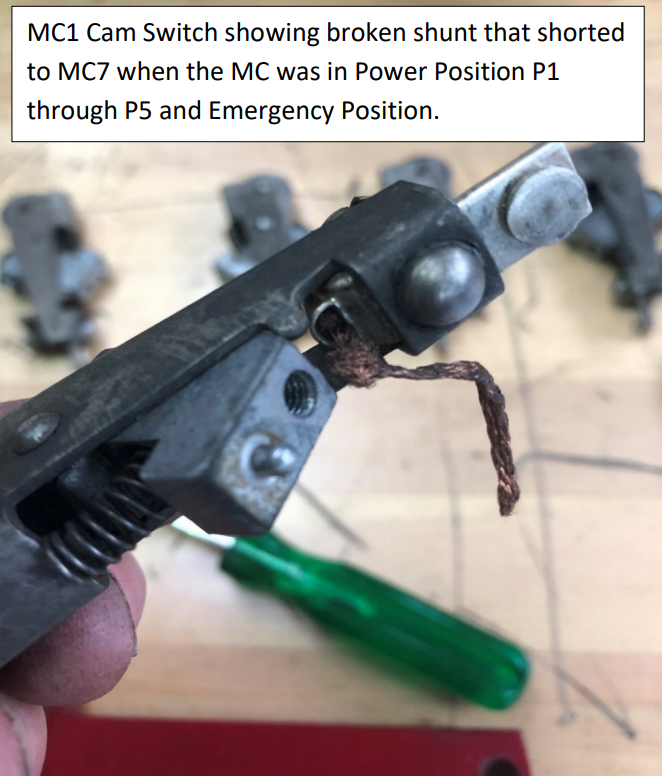Metro Reasons: All doors on an Orange Line train were open when it was moving, a report says

Metro CCTV screenshot showing an open door as an Orange Line train departed Dunn Loring for downtown. All images via WMSC.
All doors on an eight-car Orange Line train were open back in May when it left the Dunn Loring station, a Metro report submitted to the Washington Metrorail Safety Commission (WMSC) says. Metro engineers traced the issue back to a broken cable, and they’re actively working to replace hardware in all similar cars.
The report approved by the WMSC at its monthly October meeting stemmed from a video tip Metro received on Facebook, showing a door of a 3000-series car open while the train was departing Dunn Loring station towards downtown on May 19. The agency removed all of those cars from service the next day while it investigated the incident. They were returned to service on the 21st.
The report blames components within the “Master Controller,” the device an operator uses to control acceleration and braking on the train, for causing the malfunction which allowed its doors to be open while moving. A copper shunt cable broke and came in contact with another part, which energized the “Door Check Relay (DCKR)” and allowed the train to move, it reads.
In addition to the hardware failure, the report says the operator didn’t fully comply with one of the agency’s Standard Operating Procedures which requires them to ensure the lights above each door fully extinguish, indicating the doors are all closed.
Simple electrical circuits define train movement
Metro trains are operated by a train operator moving a handle with 11 positions: five which tell the train to brake at different rates, one for coasting, and five telling the train to accelerate at different rates. Through the use of a series of switches called Cam switches, the movement of the Master Controller connects and disconnects a set of circuits which instruct the train on how to operate.
When a circuit in the Master Controller is connected it becomes energized with an electrical signal and indicates a “high” status, or 1. When a circuit is disconnected it becomes deenergized and indicates a ‘low” status, or 0. These 1’s and 0’s are transmitted through the train to indicate things like brake status, propulsion status, and door status.
With the DCKR relay energized, the train was being told that all doors on the consist were closed, even when they weren’t. The report states the red lights above the doors on the train, which indicate if the doors on that car are open or not, were still illuminated, conflicting with the separate DCKR relay signal.
Of the 22 Cam switch assemblies contained within the Master Controller, Metro engineers found 13 in good condition, two with “major defects,” two with “significant defects,” and five others with “minor findings.”
The copper shunt—essentially a simple metal cable—on Cam switch “MC1” was found to be completely broken off. The cable made contact with another switch “MC7” and allowed the train signaling to indicate that doors were completely closed even when they weren’t.
The root cause of the incident which allowed a 3000-series train to move with its doors open, according to Metro. 
Another cable was found to be almost completely broken off, which could potentially have led to a similar though different situation. The damage to the cable was caused by wear during movement, according to the report.
The second major defect found by WMATA engineers when examining the train’s Master Controller. 
What happened exactly?
Data from the train’s event recorder tell us how the incident occurred. The train arrived at Dunn Loring at 1:53 pm, and the operator pushed the left-hand door open button six seconds later. The left-hand door close button was then pressed twice within a second, potentially to cause audible announcements to play so customers would enter or exit the train. The left-hand door open button was then pressed.
Instead of continuing to indicate that train doors were still open, the train operator’s console displayed “All Doors Closed” as indicated by the falsely-energized DCKR signal. The operator then began moving the train forward. The train had accelerated to 33mph when the operator applied brakes, which caused the DCKR signal to drop, which caused the train to slow.
“Several doors in the train consist were still open causing the DCKR to drop for about 6-7 seconds at approximately 33 mph with proper brake application,” the report reads. The train doors were commanded closed when a second signal, the Zero Speed Relay, dropped to indicate the train was in motion, however “due to the inertia respect to the direction of motion, some doors closed after more than 8 seconds.”
An emergency service bulletin was issued after Metro investigated the occurrence, and the Office of Car Maintenance performed a fleet-wide inspection for the Master Controller on all 2000 and 3000-series cars. The WMATA Maintenance Repair and Overhaul shop was instructed to “overhaul” all of the type of affected Master Controller devices which was “expected to begin…in November of 2019.”
The incident railcar was put back in service on June 14 after the defective Master Controller was replaced.
Metro Reasons is a regular breaking news, investigative reporting, and analysis column by Stephen Repetski about everything Metro. Please send tips to Metro Reasons.
